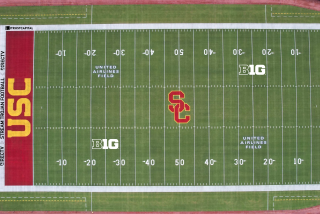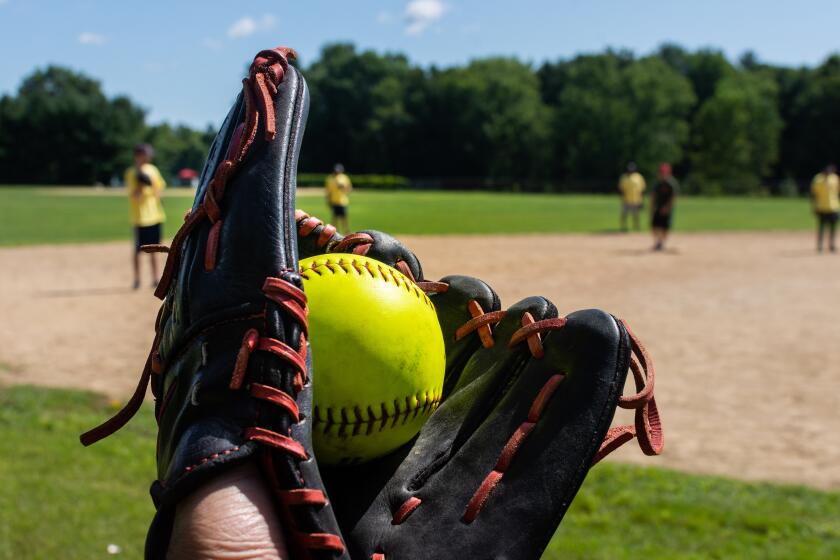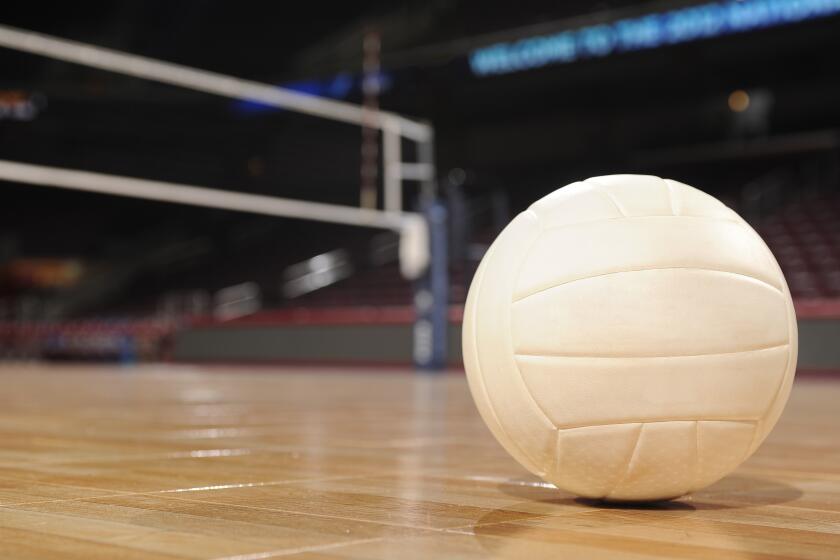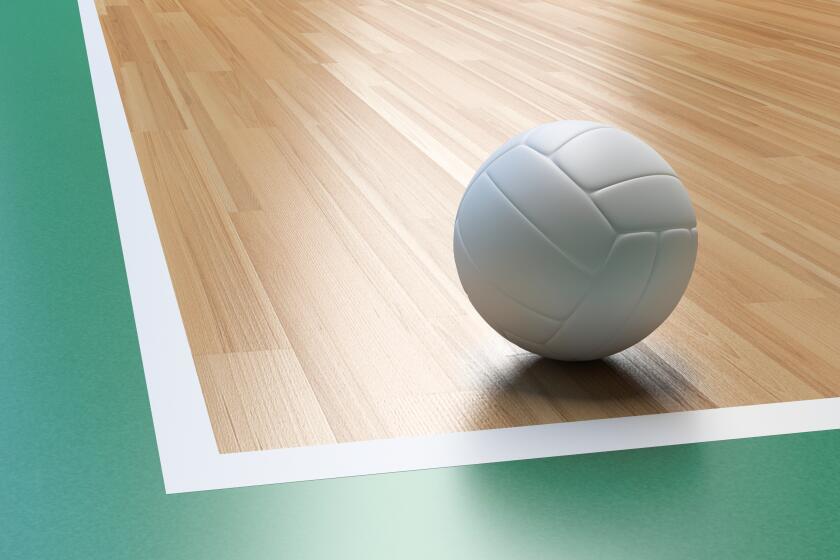SDSU vs. IOWA : 9 Days to Go : THE HAWKS : Now They’re the Symbol of the Farm State’s Success
- Share via
IOWA CITY — A damp fog hung in the freezing air much of the week. Steam billowed from the tops of buildings. Except for patches of white at the edge of the Iowa River, the color scheme was an unending gray.
Still, no one in this university town of about 60,000 was complaining. With a few days respite from the harsh Midwestern winter, attention was focused on Christmas shopping, mid-term examinations and the exploits of the University of Iowa football, basketball and wrestling teams.
This is a bountiful season for the Hawkeyes, or Hawks, as they’re known here.
The football team is headed for the Holiday Bowl in San Diego, the sixth consecutive bowl game under Coach Hayden Fry. The basketball team, coached by Tom Davis, is ranked No. 3 in the nation this week and has appeared in the NCAA Tournament seven of the last eight years. The wrestling team, coached by Dan Gable, has won nine consecutive NCAA championships and is favored to make it a record 10 in a row. No college team in any sport has ever won 10 straight NCAA championships.
College athletics is big business all over the country, but in few places is it healthier or more meaningful to the citizenry of an entire state.
“We are one of the rallying points in the state of Iowa, no doubt about it,” Athletic Director Bump Elliott said. “It’s hard to measure, but it’s something you can certainly feel.”
The Hawkeye football and basketball teams have played to sellouts for seven straight years, and their attraction for the state’s 2.8-million people is strong.
The plight of Iowa’s farmers has been well-documented. The state’s economy is depressed. The papers this week featured news of possible cuts in farm subsidies, a sensitive and controversial issue.
Overall, the economic news is grim, but a recent item in a newspaper provided a little humor. A Des Moines man offered a free hairpiece to any Iowa trade-school or college student who agrees to stay in the state at least two years after graduation. It was an attempt to stop the exodus of young people from the state.
Free wigs may not solve Iowa’s problems, and neither will intercollegiate athletics. But there’s no question that people need a diversion, an escape from their problems, and the Iowa Hawkeyes fill the need.
“There is less recreation available to people in our state than in some other places, like Southern California,” Elliott said. “Because the environment is restricted, people turn to the university as their outlet for entertainment.
“Given the existing economic conditions, our support is just great. People turn out and they support us with contributions. Thank goodness we have a good product.”
The school’s athletic budget, about $10 million, ranks in the middle among Big Ten schools, according to Elliott. The school’s athletic fund-raising effort produces about $3 million annually and was the first in the Big Ten to surpass that level.
A $20-million, 15,000-seat indoor arena was constructed four years ago after a fund-raising drive of only one year. Consultants hired by the university had predicted it would take several years, and were left scratching their heads when the money poured in, an athletic department spokesman said.
“People here are pretty responsive,” Elliott said.
“I see our success reflected in financial giving to other areas of the university. People feel good about our overall situation.
“Athletics gets the publicity, but it contributes to an overall good feeling about the school and the state. There’s no question there’s been a tremendous response.”
The success of the football program under Fry, who has produced two Rose Bowl teams in the past five years, has led to the renovation and enlargement of ancient Kinnick Stadium, built in 1929.
The 66,000-seat stadium is sold out for the season before the first game. Such is the demand for tickets that more than 10,000 fans drove four hours to see the final regular-season game in Minneapolis this year.
The school’s allotment of 10,000 Holiday Bowl seats was quickly exhausted, prompting some clever fans to scan want ads in Utah newspapers in hopes of finding tickets bought by expectant BYU followers. Some 800 Iowans were successful in that effort.
Football is king now, but it wasn’t that way until Fry’s arrival in 1979.
In the pre-Fry days, wrestling set a standard of excellence for Iowa athletics.
“The fans just swamped us back then,” said Gable, a legendary figure in Iowa athletics. “We had won several national championships before Hayden Fry came, and our program was in front of the nation.
“Even though football has gotten so big, it hasn’t really hurt wrestling. It’s meant more money for everyone in the athletic department. We may have a few less fans at some of our meets, but I don’t know that it’s because of football. Heck, winning gets pretty routine, you know.”
Winning was anything but routine in Iowa football until Fry came in and tried to create instant tradition through his own marketing plan.
“I’ve studied winners all over the country,” Fry said. “Not enough people in Iowa identified with the black and gold. At schools like Oklahoma and Nebraska, everybody wears red to the games. We wanted people here to look at the black and gold and say, ‘That’s my team!’ ”
Convinced that people identify with a winning look, he scrapped the team’s old uniforms and had them redesigned along the lines of the Pittsburgh Steelers.
“We copied them exactly, right down to the width of the stripe on the pants,” Fry said. Not that the Steelers objected--they sent Terry Bradshaw’s uniform as a model.
“We even changed the logo on the helmet,” he said. “We had a new one designed to show a fierce-looking Hawk, only one like it in the world. People complained at first, but they love a winner.”
But Fry didn’t stop at the uniforms.
“I called up the vice president of a big department store chain in New York and got the right to market items in Iowa and six other states,” he said. “We marketed umbrellas, T-shirts, golf balls, cigarette lighters, you name it. I must have more than 400 different things in the den of my home--all of them in black and gold.”
Fry eventually got out of the marketing business, but he hasn’t abandoned his objective of winning the Rose Bowl and a national championship.
Those goals seemed far-fetched when he took over in 1979, but no longer. Indeed, those expectations stand in sharp contrast with the first years of Elliott’s reign in the early 1970s.
“People expect more now, but they’re still not as demanding as they are in a place like Texas,” Elliott said. “They certainly expect us to be productive, but they don’t feel it has to be that way every year.
“Since we’re not in a highly competitive area for entertainment dollars, we’re not forced into thinking we have to get better and better all the time. We’re really pretty down to earth.”
That earthiness provides a balance in the school’s approach to athletics and, to an extent, helps protect Fry from unrelenting alumni pressure.
“The difference in a school like this and some place like Texas or USC,” Elliott said, “is that we don’t have the huge individual contributors that come from oil money or a city like Los Angeles.
“It’s those kinds of contributors who put the really heavy pressure on a program and a coach. We raise money from a lot of people giving a reasonable amount, but not a ton of money.”
Fry is not expected to come up with a 10-1 record and a Rose Bowl team every year.
“The record could be 8-3 or 3-8 and we’d feel the same about his program,” Elliott said. “We can afford to feel that way since we don’t have the long-standing tradition of a program like Texas, and no large concentrated sources of money to apply the pressure.”
More to Read
Go beyond the scoreboard
Get the latest on L.A.'s teams in the daily Sports Report newsletter.
You may occasionally receive promotional content from the Los Angeles Times.










